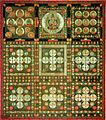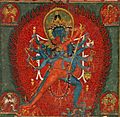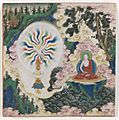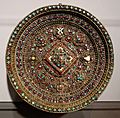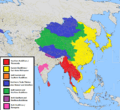Vajrayana facts for kids
Vajrayana is a special type of Buddhism that started in India. From there, it traveled to places like Tibet, Mongolia, and Bhutan. After 1959, when Tibet became part of China, the Tibetan form of Vajrayana became very popular in many Western countries.
Vajrayana is one of the three main types of Buddhism. The other two are Theravada and Mahayana. Vajrayana Buddhism grew out of Mahayana Buddhism. Tibetan Vajrayana Buddhism has its own holy books written in Tibetan and Sanskrit. It also uses older Mahayana texts in Sanskrit and Theravada texts in the Pali language.
Sometimes, people in Western countries call Vajrayana "Tantric Buddhism". Tantric practice is one part of Vajrayana, but there are other forms too. Vajrayana Buddhism is also known as "The Diamond Vehicle".
Contents
What Makes Vajrayana Special?
Vajrayana has some unique features:
- Using mantras, which are special sounds or words repeated in a chant.
- A strong focus on the guru, who is a spiritual teacher.
- The importance of meditation. This includes ways to focus your mind, like imagining bodhisattvas (enlightened beings who help others).
People learn these practices through a special ceremony called an initiation or empowerment.
Tibetan Vajrayana: Schools and Teachings
There are four main schools, or traditions, of Tibetan Buddhism: Nyingma, Sakya, Kagyu, and Geluk. All these schools see themselves as part of the Mahayana tradition. Mahayana is the most common form of Buddhism in countries like China, Korea, and Japan.
Different Levels of Practice
In the ancient Nyingma school, the teachings are divided into six levels. These levels help followers learn more and more deeply.
- Outer Tantras
- Kriyayoga
- Charyayoga
- Yogatantra
- Inner Tantras (also called Anuttarayogatantra)
- Mahayoga
- Anuyoga
- Atiyoga (also known as Dzogchen)
The new schools (Sakya, Kagyu, and Geluk) divide the teachings into four levels. The first three levels are similar to the Nyingma school. The last level is simply called Anuttarayogatantra ("Highest Yoga Tantra"). These Highest Yoga Tantras are grouped into "mother," "father," and "non-dual" tantras. Instead of Dzogchen, the new schools use a practice called Mahamudra.
Images for kids
-
Diamond Realm Mandala, showing the final understanding of Vairocana Buddha.
-
Tangut Auspicious Tantra of All-Reaching Union.
-
Manjushri, a bodhisattva linked to wisdom.
-
Mani stones, with the "om mani padme hum" mantra carved on them.
-
Dagchen Rinpoche closing the Hevajra Mandala after a ceremony.
-
Portrait of Kobo Daishi (Kukai) holding a vajra and a mala.
-
Yamabushi priests at Gose, Nara.
-
Vajrayana adopted deities like Bhairava, known as Yamantaka in Tibetan Buddhism.
See also
 In Spanish: Vajrayāna para niños
In Spanish: Vajrayāna para niños


